Assessing the Preference of Rabbit Does to Social Contact or Seclusion: Results of Different Investigations
Simple Summary
Abstract
1. Introduction
2. Materials and Methods
2.1. Experiment 1
2.1.1. Animals, Housing, and Husbandry
- A group zone (located in the center of the cage) where the rabbits had the possibility to be in physical contact with the others;
- Four isolation areas connected with sliding doors where the rabbits had the opportunity to stay secluded.
2.1.2. Observation Method
2.2. Experiment 2
Animals, Housing, and Husbandry
2.3. Statistical Analysis
3. Results and Discussion
- Physiological state—the female does in different physiological states (nulliparous or during their reproductive functions) had a different response;
- Individual behavior—individual does had a different preference for seclusion or group;
- Presence/absence of feeders and drinkers—the presence of the feeders and drinkers in different areas of the cage could affect the use of resources;
- Video recording—the video recording system (continuous or not), the coding scheme, and the length of the recording probably had an effect on the result.
4. General Conclusions
Author Contributions
Funding
Conflicts of Interest
References
- Stodart, E.; Myers, K. A comparison of behaviour, reproduction, and mortality of wild and domestic rabbits in confined population. CSIRO Wildl. Res. 1964, 9, 144–159. [Google Scholar] [CrossRef]
- Morgan, K.N.; Tromborg, C.T. Sources of stress in captivity. Appl. Anim. Behav. Sci. 2007, 102, 262–302. [Google Scholar] [CrossRef]
- Szendrő, Z.; Trocino, A.; Hoy, S.; Xiccato, G.; Villagrá, A.; Maertens, L. A review of recent research outcomes on the housing of farmed domestic rabbits: Reproducing does. World Rabbit Sci. 2019, 27, 1–14. [Google Scholar]
- Mugnai, C.; Dal Bosco, A.; Castellini, C. Effect of different rearing systems and pre-kindling handling on behaviour and performance of rabbit does. Appl. Anim. Behav. Sci. 2009, 118, 91–100. [Google Scholar] [CrossRef]
- Andrist, C.A.; Bigler, L.M.; Würbel, H.; Roth, B.A. Effects of group stability on aggression, stress and injuries in breeding rabbits. Appl. Anim. Behav. Sci. 2012, 142, 182–188. [Google Scholar] [CrossRef]
- Andrist, C.A.; van den Borne, B.H.; Bigler, L.M.; Buchwalder, T.; Roth, B.A. Epidemiologic survey in Swiss group-housed breeding rabbits: Extent of lesions and potential risk factors. Prev. Vet. Med. 2013, 108, 218–224. [Google Scholar] [CrossRef] [PubMed]
- Rommers, J.M.; Boiti, C.; De Jong, I.; Brecchia, G. Performance and behaviour of rabbit does in a group-housing system with natural mating or artificial insemination. Reprod. Nutr. Dev. 2006, 46, 677–687. [Google Scholar] [CrossRef] [PubMed]
- Kreye, D. Personal communication, 2019.
- Emanuela Albonetti, M.; Dessí-Fulgheri, F.; Farabollini, F. Intrafemale agonistic interactions in the domestic rabbit (Oryctolagus cuniculus L.). Aggress. Behav. 1990, 16, 77–86. [Google Scholar] [CrossRef]
- Rommers, J.M.; Gunnink, H.; Klop, A.; de Jong, I.C. Dynamics in aggressive behaviour of rabbit does in a group housing system: A descriptive study. In Proceedings of the 17th Internationale Tagung uber Haltung und Krankheiten der Kaninchen, Pelztiere und Heimtiere, Celle, Germany, 11–12 May 2011. [Google Scholar]
- Rommers, J.; de Greef, K.H. Are combi parks just as useful as regular parks for fatteners for part-time group housing of rabbit does? World Rabbit Sci. 2018, 26, 299–305. [Google Scholar] [CrossRef]
- Jensen, P. Maternal behaviour and mother-young interactions during lactation in free-ranging domestic pigs. Appl. Anim. Behav. Sci. 1988, 20, 297–308. [Google Scholar] [CrossRef]
- Dal Bosco, A.; Mugnai, C.; Martino, M.; Szendrő, Z.; Mattioli, S.; Cambiotti, V.; Castellini, C. Housing rabbit does in a combi system with removable walls: Effect on behaviour and reproductive performance. Animals 2019, 9, 528. [Google Scholar] [CrossRef] [PubMed]
- European Commission. Directive 2010/63/EU of the European Parliament and of the Council of 22 September 2010 on Protection of Animals Used for Scientific Purpose. Off. J. Eur. Union 2010, 53, 33–79. [Google Scholar]
- Buhl, M.; Damme, K.; Hoy, S.T. Erste ergebnisse zu einem gruppenhaltungssystem für häsinnen mit jungen. In Proceedings of the 19th International Symposium on Housing and Diseases of Rabbits, fur providing animals and pet animals, Celle, Germany, 27–28 May 2015; pp. 229–236. [Google Scholar]
- Hoy, S.; Matics, Z. Alternative housing systems for rabbit does. In Proceedings of the 11th World Rabbit Congress, Qingdao, China, 15–18 June 2016; pp. 637–651. [Google Scholar]
- StataCorp. Stata Statistical Software: Release 14; StataCorp LP: College Station, TX, USA, 2015. [Google Scholar]
- Molento, C.F.M. Contribuição à literatura portuguesa sobre bem-estar animal. Rev. Sci. Tech. Off. Int. Epiz. 2005, 24, 483–492. [Google Scholar]
- Panksepp, J. Emotions as natural kinds within the mammalian brain. In Handbook of Emotions; Guilford Press: New York, NY, USA, 2000; pp. 137–156. [Google Scholar]
- Szendrő, Z.; McNitt, J.I. Housing of rabbit does: Group and individual systems: A review. Livest. Sci. 2012, 150, 1–10. [Google Scholar]
- Gonzá, G.; Rosenblatt, J.S. Maternal behavior in rabbits: A historical and multidisciplinary perspective. In Advances in the Study of Behavior; Academic Press: Cambridge, MA, USA, 1996; Volume 25, pp. 333–360. [Google Scholar]
- Findlay, A.L.; Roth, L.L. Long-term dissociation of nursing behavior and the condition of the mammary gland in the rabbit. J. Comp. Physiol. Psychol. 1970, 72, 341. [Google Scholar] [CrossRef] [PubMed]
- von Holst, D.; Hutzelmeyer, H.; Kaetzke, P.; Khaschei, M.; Rödel, H.G.; Schrutka, H. Social rank, fecundity and lifetime reproductive success in wild European rabbits (Oryctolagus cuniculus). Behav. Ecol. Sociobiol. 2002, 51, 245–254. [Google Scholar] [CrossRef]
- Schuh, D.; Selzer, D.; Hoy, S. Einfluss der gruppengröße auf das sozialverhalten von wild-und hauskaninchen. In Proceedings of the 13th Arbeitstagung über Haltung und Krankheiten der Kaninchen, Pelztiere und Heimtiere, Celle, Germany, 14–15 May 2003. [Google Scholar]
- St, H.; Schuh, D. Sociometric investigations in groups of wild and domestic rabbits with one buck and two or three does. In Proceedings of the 8th World Rabbit Congress, Puebla, Mexico, 7–10 September 2004; pp. 7–10. [Google Scholar]
- Gunn, D.; Morton, D.B. Inventory of the behavior of New Zealand White rabbits in laboratory cages. Appl. Anim. Behav. Sci. 1995, 45, 277–292. [Google Scholar] [CrossRef]
- McGlone, J.J.; Curtis, S.E. Behavior and performance of weanling pigs in pens equipped with hide areas. J. Anim. Sci. 1985, 60, 20–24. [Google Scholar] [CrossRef] [PubMed]
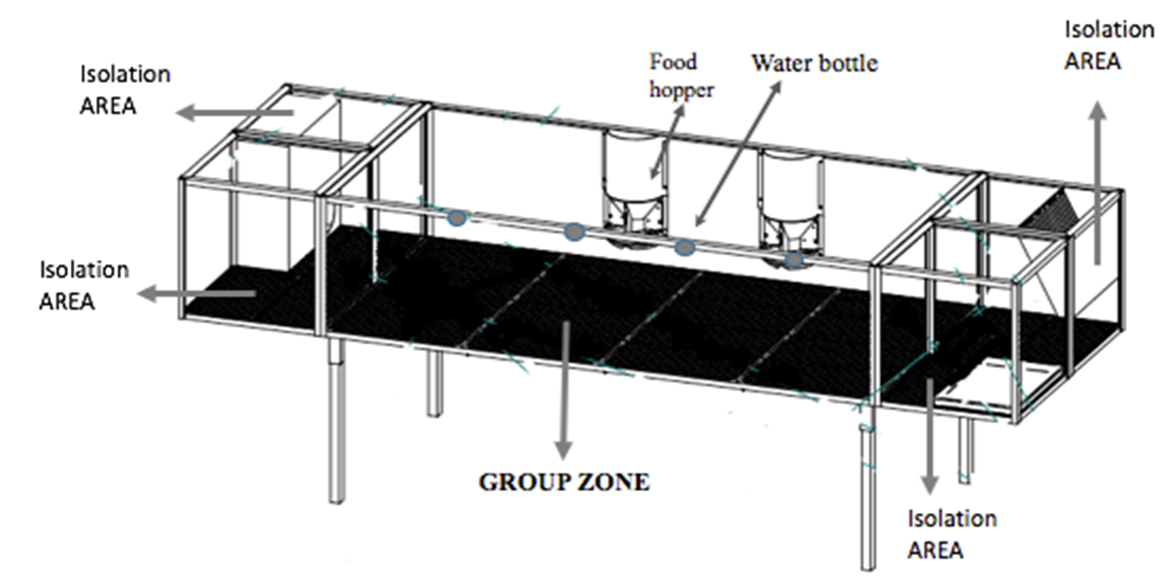
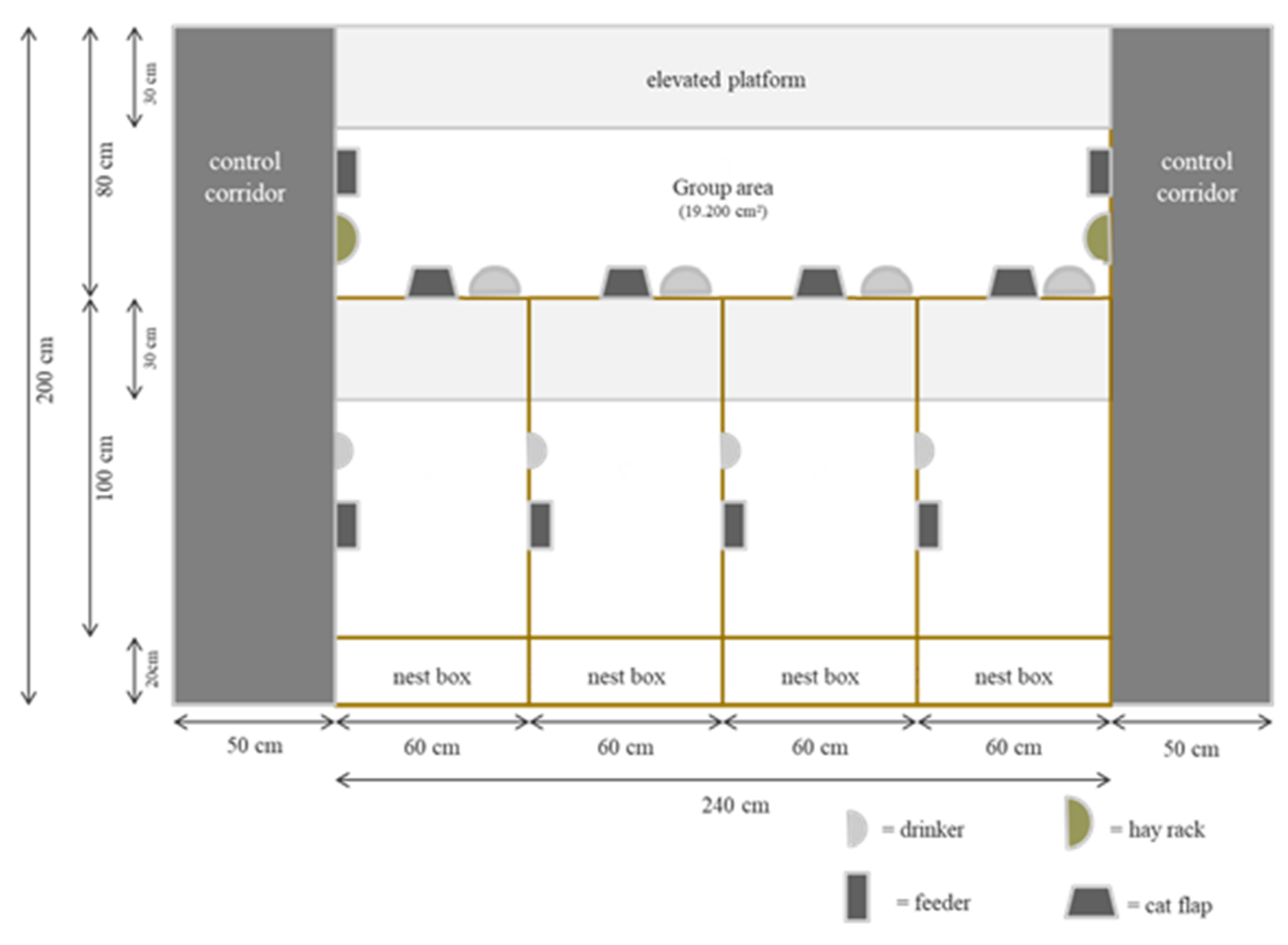
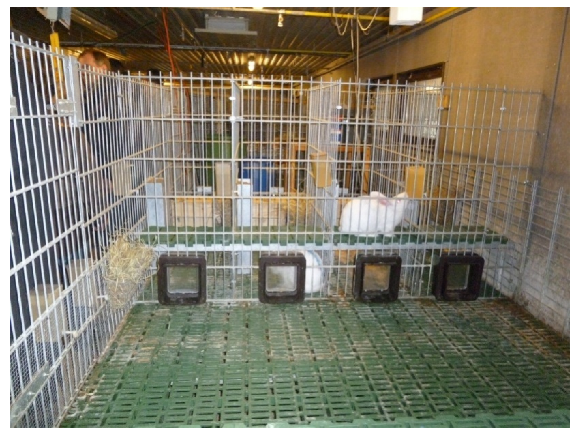
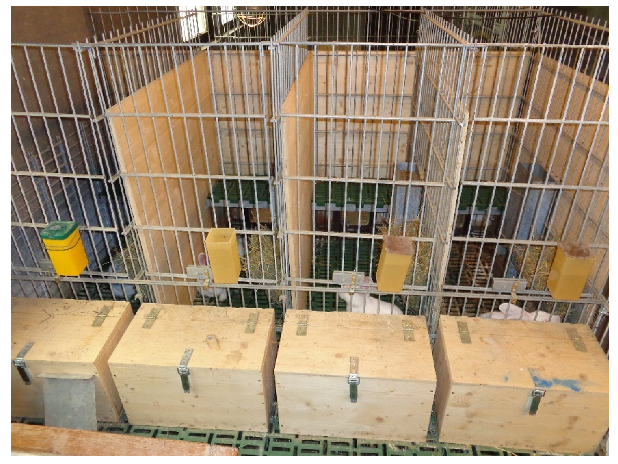
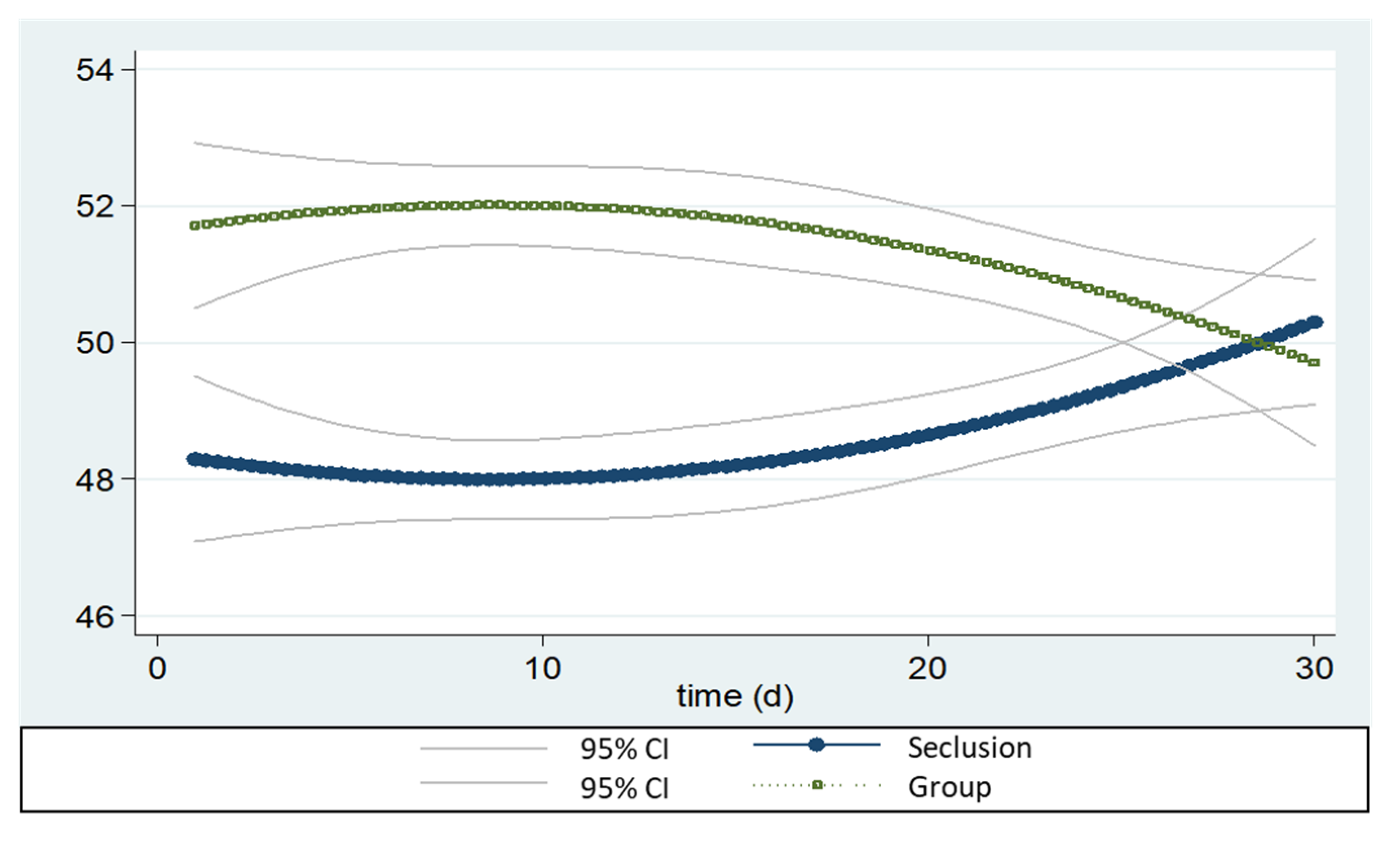
| Experiment 1 | |
| Seclusion | 49.61 a |
| Group | 50.39 a |
| X2 | 2.10 |
| Experiment 2 | |
| Seclusion | 71.90 b |
| Group | 28.10 a |
| X2 | 10.30 |
| Cycle 1 | Cycle 2 | Cycle 3 | SE | ||||||||||
|---|---|---|---|---|---|---|---|---|---|---|---|---|---|
| Doe | 1 | 2 | 3 | 4 | 1 | 2 | 3 | 4 | 1 | 2 | 3 | 4 | |
| Occupation time (%) | |||||||||||||
| Single area | 100 b | 68.3 a | 47.8 a | 46.6 a | 50.0 a | 72.3 ab | 51.6 a | 100 b | 82.5 b | 94.4 b | 50.0 a | 100 b | 13.20 |
| Group area | 0 a | 31.7 b | 52.2 b | 53.4 b | 50.0 b | 27.7 ab | 48.4 b | 0 a | 17.5 a | 5.6 a | 50.0 b | 0 a | 8.34 |
© 2020 by the authors. Licensee MDPI, Basel, Switzerland. This article is an open access article distributed under the terms and conditions of the Creative Commons Attribution (CC BY) license (http://creativecommons.org/licenses/by/4.0/).
Share and Cite
Dal Bosco, A.; Cartoni Mancinelli, A.; Hoy, S.; Martino, M.; Mattioli, S.; Cotozzolo, E.; Castellini, C. Assessing the Preference of Rabbit Does to Social Contact or Seclusion: Results of Different Investigations. Animals 2020, 10, 286. https://doi.org/10.3390/ani10020286
Dal Bosco A, Cartoni Mancinelli A, Hoy S, Martino M, Mattioli S, Cotozzolo E, Castellini C. Assessing the Preference of Rabbit Does to Social Contact or Seclusion: Results of Different Investigations. Animals. 2020; 10(2):286. https://doi.org/10.3390/ani10020286
Chicago/Turabian StyleDal Bosco, Alessandro, Alice Cartoni Mancinelli, Steffen Hoy, Melania Martino, Simona Mattioli, Elisa Cotozzolo, and Cesare Castellini. 2020. "Assessing the Preference of Rabbit Does to Social Contact or Seclusion: Results of Different Investigations" Animals 10, no. 2: 286. https://doi.org/10.3390/ani10020286
APA StyleDal Bosco, A., Cartoni Mancinelli, A., Hoy, S., Martino, M., Mattioli, S., Cotozzolo, E., & Castellini, C. (2020). Assessing the Preference of Rabbit Does to Social Contact or Seclusion: Results of Different Investigations. Animals, 10(2), 286. https://doi.org/10.3390/ani10020286







